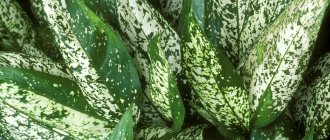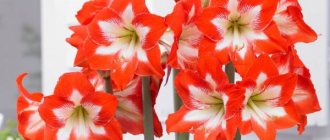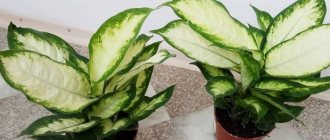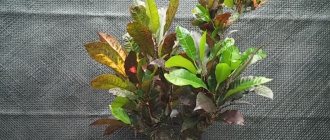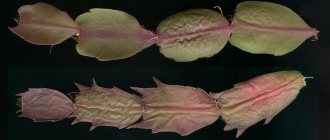Review author: Terrari School of Design
Decembrist belongs to the cactus family, but in appearance it looks more like an orchid; it has no needles, but many plates replacing leaves and stems. It is also called Schlumbergera, Zygocactus and Christmas tree because it dawns during the New Year.
Many flower growers do not know how to plant a Decembrist flower, so let’s look into this issue further. They usually buy a young plant in a pot. It is loved because of its simplified care and lush appearance during the flowering period.
Where does Decembrist grow and why is it associated with hummingbirds?
Decembrist grows naturally in South America, but mostly in Brazil. However, these species differ from the domestic Schlumbergera because they prefer epiphytic symbiosis with various plants of the tropical evergreen forest, they connect with their trunks or root systems.
If you look at the photo of Decembrist flowers, you can note their beautiful flowering, thanks to this, flower growers really like to keep the plant at home. Externally, it is worth noting characteristics similar to a shrub: many segmented leaf-shaped or triangular shoots based on a soft texture with a length of up to 0.5 m. During the flowering period, it is their upper part that is covered with flowers 5-8 cm in size and a multi-tiered corolla system similar to a star with protrusion of stamens.
The flowers have too long a tube, so pollination is possible only for tiny birds of the hummingbird family. For this work, they have at least 6-8 weeks until the buds fully open. After this, the beauty of the flowers lasts for 4-5 days, then they fade.
Interesting fact: Decembrist is often confused with Hatiora because they have similar flowers and are similar in DNA structure.
A little about Schlumberger
The plant was brought to Europe by Cunningham in 1816. The plant Cunningham tended bloomed with scarlet flowers.
But then breeders developed Decembrist species with snow-white, soft pink, lilac, and bright orange flowers. Nowadays you can even buy a plant with flowers of several colors.
Decembrist has many other names: zygocactus, epiphytic cactus, Christmas tree. A Christmas tree can live 15-20 years if it is properly cared for.
When grafted, a standard form of Decembrist is obtained, which blooms very profusely. To do this, purchase the Peirescia cactus. The upper part of the cactus is cut off with a sharp knife, then the stem is split slightly and then a cutting of 2-3 segments of the Decembrist stem is placed into the split.
Finally, it is secured and wrapped with wool thread. When the sections grow together, the foliage is torn off the cactus and the thread is removed. When the crown of the Christmas tree grows, it is tied to a peg, then it will not break off.
Decembrist special flower
All plants are different in some way, but Decembrist stands out for its flowering period. In December-January, most house plants rest, and it begins to please the eye. But it also stands out for other qualities:
- Does not like western or southern sides of the window sill. Too intense lighting can damage the terminal segments of shoots, which often causes death;
- In summer, he needs shade protection from exposure to direct rays of the sun;
- In summer, he needs a shower or regular spraying;
- If proper care is provided, then you can hope for New Year's flowers for 15-20 years.
- You should not move the plant to another place during the formation of buds. Even turning the pot can cause harm.
- Standard cultivation is allowed, but you can resort to hanging the plant.
How to plant Schlumbergera?
Decembrist is a fast-growing plant, so if there is a need to replant it in the spring, then at the same time you can plant a young cutting, and by next winter it will already delight you with a thick, overgrown crown, and maybe even flowering.
The process of transplantation and seating is standard:
- Prepare a pot of the required diameter. Drainage (1/3 of the pot) and some substrate are placed at the bottom.
- Carefully, shaking slightly, remove the zygocactus from the old container and, having separated the cuttings for planting, place the plant in a new pot. Fill the container with fresh soil, without compacting it too much.
- The separated cuttings are placed in a new pot in a similar way.
Decembrist varieties
Numerous varieties of Decembrist are able to impress with the different colors of flowers and the intricate shapes of inconspicuous petals: narrow, oval-like, terry, with pointed tips.
Every year gardeners experiment and get new versions:
- White Christmas. A hybrid species characterized by an increased duration of snow-white flowering. Thanks to this, the variety has gained worldwide fame.
- Kris Kringle. It is distinguished by the compactness of the crown of the bush with the miniature shape of very short shoots. It has a bright red color.
- Pasadena. It is distinguished by its effective form based on its pronounced red color. Has large leaves.
- Santa Cruz. It has expressive colors with a predominance of orange interspersed with a hint of red. During the growing season, the bush immediately acquires a rich, spectacular color, which is very popular among gardeners.
Growing by seeds or cuttings?
Specialists use seed propagation to breed new varieties, but at home it is easier to rely on cuttings. Cuttings greatly simplify caring for the Decembrist, since the process is not associated with difficult issues. Thanks to him, maternal characteristics are fully transmitted. But experiments are not available. There will be no new color of flowers or shape of leaves.
Cuttings are carried out in the spring immediately after flowering. But usually Decembrist takes root well at any time of the year. How this procedure is performed:
- A viable and intact shoot with 2-3 segments is carefully detached from the bush using a clockwise circular motion. This work is done by hand;
- The planting material is kept outdoors for 48 hours. This is necessary to dry it. Now you can plant it in the prepared substrate;
- To retain moisture, the planting site is covered with a jar or film. But the plant opens every day for a short period of time for ventilation.
Important: If new segments appear, the plant has taken root successfully.
When can you break off branches after flowering?
Depending on the variety, Schlumbergera can bloom up to twice per season from two weeks to a month or a little more. In order not to interrupt possible flowering, it is better to wait until the end of spring, when the Decembrist will probably no longer put out buds. Now the flower is ready for pruning.
After flowering, Schlumbergera should wait a month before pruning. The fact is that this is a “resting period” for the plant, so you can’t pinch or trim it. Do not be alarmed if at this time the plant loses some of its leaves and flowers, this is normal.
Proper care
After successful planting, the normal development of the Decembrist requires special care. But this activity will not require much time and will bring only positive emotions:
- Young Decembrists are transplanted every year. To do this, use a pot that is 1-2 cm larger than the previous one. But you should focus on narrow versions. They are larger in height, but the diameter remains the same. In a small space, a plant's roots grow faster because it intends to devote more energy to rooting in an unfavorable environment;
- If you do the right pruning, you can quickly achieve neat and beautiful flowering. But you cannot cut plant segments; they are always twisted by hand. This will enhance branching resistance; especially damaged shoots must be removed immediately so that there is no energy expenditure to maintain their viability;
- You cannot change the location of the Decembrist during the flowering period: rearrange it, turn it in the other direction. Otherwise, it may drop the buds.
Thanks to this, caring for the Decembrist at home turns into an interesting activity. The gardener bestows attention on him in the hope of results during the New Year holidays. Thanks to regular propagation, you can give young flowers to: friends, acquaintances, colleagues, relatives. Some people make good money from this.

